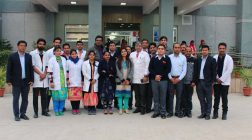Indian generic cos struggle to crack 2nd largest pharma marketExcept a few Indian players such as Lupin, none of the Indian drug makers are able to establish their presence in the $90-bn pharma market
The world’s second largest pharmaceutical pharmaceuticals market -Japan is yet to see major penetration from Indian pharmaceutical majors, especially in area of generic drugs.
Except a few Indian players such as Lupin, none of the Indian drug makers are able to establish their presence in the $90-billion pharma market.
Though Japanese Government is trying its best to make available cheap generic drugs to its 13-crore population, entry of generic drugs are seen at its lowest today.
Japan, where the government-funded National Health Insurance scheme cover every citizen, had launched a series of reforms in 2010, with the intention of expanding generic drug penetration to 30 per cent of the drug market by 2013, from 18 per cent in 2010.
A CEO of one of the top 5 Indian companies said on condition of anonymity, “In Japan, genericization has happened only to the extent of around 50 per cent while in the US, around 95 per cent of the market is generisized. So a large chunk of the market in Japan still comprises of patented products.” According to him, the regulations in Japan (PMDA) are not very clear. “Unlike USFDA, which is transparent about its regulations, there is lack of transparency in regulations in Japan. This could be a major challenge,” he added.
Vinod Dhawan, Group President – AAMLA (Asia Pacific, Africa, Middle-East & Latin America) & ROW Markets, Lupin Limited, in an interview with Business Standard last month, said, “Entry to the Japan formulations market requires dedicated R&D as well as manufacturing capabilities since regulatory requirements, specifications and sometimes strengths therein are quite different. “
Drug maker Lupin Ltd had established its presence in Japan through acquiring majority stake in generic pharma company Kyowa Pharmaceutical in 2007. In its second buy in Japan, Lupin had acquired I’rom Pharmaceutical Co, subsidiary of I’rom Holdings Co, to enter the generic injectables segment. Lupin made the buyout through its subsidiary- Kyowa Pharmaceutical Industry.
“It is a challenge to build this on an organic basis in a market which is not only lucrative but amongst the fastest growing from a generics standpoint,” added Dhawan.
Lupin, which has seen 14 per cent contribution from Japan in its FY 2012-13 revenue of Rs 9,461 crore, saw about 52 per cent growth in its revenue from Japan. Its revenue from Japan has grown to Rs 1,304 crore for FY2012-13 from Rs 860 crore for previous year.
Dhawan, said, “In the first few years starting 2003, 2004, we learnt the market dynamics and then leverage our R&D and manufacturing expertise to build partnerships in the beginning. The critical success factor was of course in using that knowledge to successfully acquire meaningful local assets.”
According to Industry experts, acquisition route is the easiest way of entering into Japanese market as setting up a subsidiary is not easy. “As per the Japanese regulations, the outside player needs to partner with a local company and form a subsidiary where the local firm needs to have majority stake. This makes operations difficult as most global companies would not like to operate as a minority stake holder as the decision making power will not be entirely in their hands,” said a senior pharma executive.
However, Active Pharmaceutical Ingredient (API) manufacturers such as Ind-Swift Labs, Suven Life Sciences and Dishman Pharma have tied up with Japanese generics producers to tap the second largest market.
Generic majors such as Glenmark also explore the potential of API market in Japan. Glenmark has recently started selling APIs in the Japanese market. Its API
manufacturing facility in Akleshwar, Gujarat has received approval from the regulatory agency of Japan (PMDA). Glenn Saldanha, Chairman & MD, Glenmark said, “We however, have no immediate plans of entering the formulations market of Japan, but our focus on selling APIs to this market will remain.”
What makes Japan still an attractive generic market is the price realisations – which are significantly higher than in most of the western economics. Based on the new target proposed by Japanese government, the generic market is likely to grow by about 30-35 per cent in volume terms by 2017 from current levels which would create an additional $7 billion opportunity for generic players over the next 3 years.










